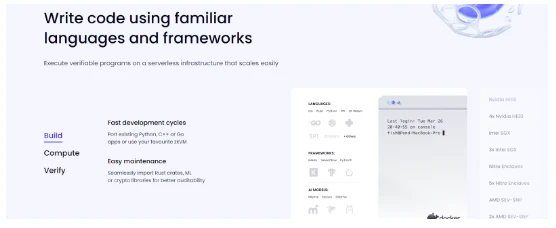加密世界从来不缺少新的故事,但只有少数故事能够被描述为既性感又务实。
比如,本轮AI超级叙事兴起以来,虽然云计算已经成为未来数字经济时代的核心生产力,但是传统Web2巨头垄断了优质的高性能GPU和算力资源,中尾端项目则毫无议价能力和自主权,更为广泛的可验证计算应用场景也面临无粮可吃的困境。
因此在AI+Crypto的趋势下,全同态加密(FHE)等概念近年来逐渐流行起来,并被广泛认为是可验证计算和AI机密数据处理的最佳解决方案之一。
本文将围绕专注于可验证云计算基础设施的资深密码学开发商 Marlin,探讨涉及 AI、MEV、Oracle、ZK、TEE 等多个叙事的 DeAI 项目如何融入当下的 AI 热潮,能否为 AI+Crypto 赛道带来新的变量。
AI下半场离不开“可验证云计算”?
众所周知,除了AIGC大模型的快速扩张,疫情初期医疗、教育、智能驾驶等无数AI场景也在快速铺开,这些场景都需要海量计算。
但对于这些细分场景而言,用户医疗、教育、智能驾驶信息等都是关乎经济甚至生命安全的关键数据:医疗保健、能源系统、带宽网络、车联网等维度的信息数据不仅直接关系到个人机密数据的安全,也需要更广泛的数据共享与合作来推动轨道发展。
但与此同时,传统云服务市场则被亚马逊网络服务(AWS)、微软Azure、谷歌云平台(GCP)等互联网巨头占据,三家公司合计占据云计算市场份额超过60%,是明显的卖方市场。
这种市场结构最明显的问题,就是普遍依赖中心化的云服务器,这意味着开发者 / 项目方对于所使用的云服务的信任,本质上高度绑定于一个或多个巨头的声誉,相当于将数据自主权和安全性拱手让给 Web2 巨头公司。
正因如此,近年来云服务商频频出现数据泄露事件,给个人和机构造成严重损失。因此,无论开发者 / 项目方如何看待去中心化这个 Crypto 世界的核心问题,从机制设计的角度让他们不能作恶(Cant Be Evil)远比相信巨头不会作恶(Dont Be Evil)要好得多。
在此背景下,如果我们仔细分析AI云计算的方向,就会发现Web2.0底层与成熟的云计算服务方案之间还存在生态差距,也就是说机密计算技术的转型面临高昂的成本,因此对于如何快速、安全的部署方案,业界还没有特别好的解决方案,无法满足AI+Web3.0所需要的一系列应用功能,这也限制了其发展势头。
因此,说白了,AI云计算市场下半场的发展,急需一套完整的面向 Web3 的区块链开发工具,从而提供一套满足去中心化、可验证、低延迟、低成本等要求的综合解决方案。从这个角度来看,去中心化、可验证的云计算服务的必要性逐渐浮出水面,正好填补了这个细分方向的空白:
在此背景下,去中心化可验证云计算服务的必要性逐渐浮现。作为利用加密技术进行计算的解决方案,它允许 在不泄露底层数据的情况下验证计算结果的正确性,既不会泄露隐私信息,又能保证关键数据不被泄露。
这些都和 Web3 的应用场景高度契合,进而引发了行业用户对机密云计算的诸多想象,因此零知识证明(ZKP)、多方计算(MPC),以及最近大热的全同态加密(FHE)等赛道都受到了市场的格外关注。
这就是Marlin想要做的事情——任何DePIN/Web2.5/AI应用,只要有低延迟、高算力的计算服务需求,其实都可以选择部署在WeTEE上,并获得与传统云服务一样的通用云计算解决方案。
重新认识 Marlin:成为 AI 世界中可验证的 L0
如果用一句话来概括Marlins在AI可验证计算领域的愿景,那就是在AI大模型训练越来越重要的当下,致力于以基础设施层插件的形式直接帮助有需要的AI算力需求者随时随地将可验证的云计算服务集成到其现有的产品中:
这本质上是一个AI世界的可验证通用L0,因此它基于TEE高性能节点增强网络和ZK可验证通信网络封装了核心功能并向项目方提供一键可调用的服务:
Marlin 采用可信执行环境(TEE)和基于零知识证明(ZKP)的协处理器,在硬件层面将数据和代码与其他进程隔离,确保数据的机密性和其中运行的计算的完整性,同时也保证计算结果的准确性、可验证性,并使其不可篡改。

同时,与大多数为特定环境(RISC-V、WASM 或 MIPS)设计且只能处理用兼容语言编写的程序的 ZK 协处理器不同,Marlins ZK 证明市场是基于电路的,因此与语言无关,允许节点选择他们想要支持的电路——他们可以直接移植现有的 Python、C++ 或 Go 应用程序,或者使用 zkVM。
同时,Marlin网络架构整体可以分为Oyster、Kalypso、以及中继网络(Marlin Relay)三匹马。
Oyster 和 Kalypso 使用可信执行环境 (TEE) 和零知识证明 (ZKP) 分别确保计算的正确性和安全性,而中继网络则负责确保不受信任的节点可以向网络贡献资源,而不会通过内置激励措施对其安全性产生不利影响:
-
作为 TEE 提供的链下服务,Oysters 的核心愿景是 让用户能够以最少的改动在 Marlin 云计算网络上部署自己的后端或实现智能合约扩展。 因此它最大的优势之一就是serverless的特性——用户不需要设置节点和选择具体使用哪个节点,可以很方便的将结果返回给用户;
-
Kalypso 代表了 Marlins 对零知识证明 (ZKP) 的灵活集成。使用 FPGA、GPU 和 ASIC 进行硬件优化可以显著加快 ZK 证明的生成速度,从而减少时间和成本。Marlin 网络依靠具有 GPU 和 FPGA 的节点来外包 ZK 证明生成,从而可以高效地处理来自客户端的请求并返回生成的证明。
-
Marlin Relay 是一个与区块链无关的、无需许可的中继网络,具有内置激励措施,可以同时与多个区块链集成。 这种激励结构确保无需信任的节点可以为网络贡献资源,而不会对网络的安全性产生不利影响。
值得注意的是,Marlins节点网络中的每个节点运维都配备了TEE,并在存储系统中构建了安全隔离的Enclave环境,确保在计算和存储数据时信息不被窥探或泄露。
并且通过ZK协议,各个节点可以向对方证明某个陈述是真实的,而不需要透露关于该陈述的任何具体数据,在保证事实正确性的同时,也保护了数据主体的信息安全。
总体来说,Marlin 作为面向 AI 的可验证云计算 L0,适用场景十分广泛,基于去中心化的分布式节点网络体系,能够 为Oracle预言机、ZK Prover系统、AI人工智能等应用场景提供节点算力、存储等网络资源服务,成为众多加密+AI应用的数据保护基石。
Marlin 与 AI World L0 的想象空间
从这个角度来看,Marlin 实际上扮演着 AI+Web3 下半场的关键基础设施角色——核心本质是真正把可验证计算带入 AI 和 Web3 世界。
比如,借助自家的L0可验证云计算组件服务,Marlin可以更进一步,将自己变成乐高积木,成为AI可验证计算+服务的关键基础设施组件,赋能各个赛道的DApp产品实现完全可验证的计算属性。
最直接的应用场景是在AI大模型训练越来越重要的当下,Marlin可以基于TEE可信执行环境协处理器为AI模型训练提供安全的模型训练和计算环境。这意味着除了ChatGPT, 不同的大模型项目可以集成Marlin或者基于Marlin构建,形成可插拔、友好使用的可验证计算中间件,从而通过可验证计算+的形式赋能。
同时更重要的是还能构建一个去中心化、透明、可验证的激励环境,让分布式节点网络转型为去中心化的云算力租赁服务网络,即通过Token激励实现更大范围的DePIN业务逻辑,降低云计算服务成本:
通过聚集闲置算力,以低成本、更灵活的部署配置,帮助创业者训练更加个性化的中小型AI模型,大幅提高资源利用率。
这只是Marlin作为可验证计算中间件所能实现的AI应用场景的冰山一角。
概括
总之,Marlin能给AI+Web3带来的最重要的想象空间是 作为L0层的基础设施,赋能各类AI项目方开发原生的可验证计算产品服务(即视为可验证计算中间件)。
事实上,作为AI+Web3时代不可或缺的核心部件,这某种程度上相当于产业的关键基础设施:
从底层算力供需匹配,到预言机数据的提供,再到基于分布式存储的去中心化前端服务等,基本上可以在逻辑上形成闭环,让用户和应用能够低成本、灵活地获得可验证的计算插件服务,有效利用和发挥数据的价值,从而为多样化的应用场景奠定基础。
可以确定的是,在AI的下半场,可验证计算赛道依然有着巨大的价值潜力等待我们去挖掘,尤其是当可验证计算+基于Web3的链上理念叠加之后,其内涵本身或许会更加宏大。
不仅仅是AI,几乎所有我们能想到的应用,比如链上娱乐、社交、游戏等等,都可以进一步拓展可验证计算/机密数据服务的想象空间。
在这个一步步的建设过程中,Marlin 很有可能成为未来全方位 AI+Web3 应用的关键底层基础设施,这也可能是 AI+Web3 时代可验证计算最大的想象空间。
本文来源网络:重新认识Marlin:可验证计算L0 AI下半场新基建
相关:Avalanche (AVAX) 分析:这次死亡交叉可能会延长修正
简言之,随着 12 小时图上出现死亡交叉,Avalanche 的价格可能会继续下跌。价格指标也表明看跌信号正在增强。投资者似乎也不太看涨,因为他们的情绪大多是悲观的。Avalanche (AVAX) 价格是少数几种显示出复苏后进一步下跌迹象的山寨币之一。让山寨币更加困难的是,即使是 AVAX 投资者也不期待反弹。Avalanche 注定要回调吗?在撰写本文时,Avalanche 的价格在 $40 下方交易,此前几天经历了回调和小幅回升。虽然市场对价格进一步上涨的希望升温,但 AVAX 的情况并非如此。这是因为……







